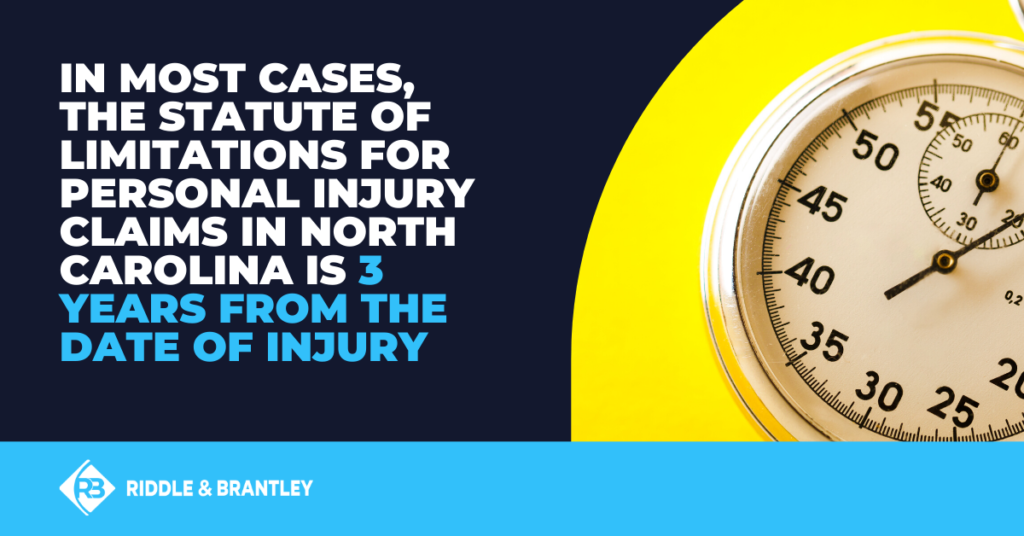If you were injured due to someone else’s negligence, you have a limited amount of time to pursue legal action against the responsible party. It's critically important that you not miss the deadline to file a personal injury claim or lawsuit. Doing so may mean that you cannot seek compensation for your damages.
The Statute of Limitations
As in all cases for remedy under civil law for damages, North Carolina has applicable periods of limitation (called Statute of Limitations) that define the period of time in which an action must be brought, or the claim is considered abandoned or time barred.
Other states have statutes of limitations for various claims and lawsuits, however they are not all the same. In this article, we'll do our best to familiarize you with how long you have to file a personal injury claim in North Carolina based on our state's unique statute of limitations.
IMPORTANT: Remember, if you've been injured in an accident, call an experienced personal injury lawyer right away for a free consultation — our legal team can be reached at 1-800-525-7111 or by completing the fast and convenient form below.
How Long Do I Have to File a Personal Injury Claim in North Carolina?

In North Carolina, the type of action determines the appropriate time period of the Statute of Limitations. Generally, the Statute of Limitations for personal injury cases in North Carolina is three years from the date of injury, or two years from the date of death in wrongful death cases. There are certain exceptions, however.
There are many different deadlines for the Statute of Limitations in North Carolina, and they vary depending on what type of case you want to file. However, in the areas of personal injury, wrongful death and workers compensation, there are generally two time periods that we focus on the most.
In North Carolina, the Statute of Limitations for personal injury cases is usually:
- 3 years from the date of injury to settle your claim or file a lawsuit for injury or breach of contract
- 2 years for wrongful death and workers compensation claims.
For specific reference under North Carolina Statutes, refer to NCGS section 1-52 (three years), NCGS section 1-53 (two years), and NCHS section 1-51 (one year).
To be clear: if you do not file a personal injury claim within the time period designated by the statute of limitations in North Carolina, you may be barred from seeking compensation for your damages. This is why it's so important to talk with an experienced North Carolina personal injury lawyer immediately after an accident. An attorney can listen to you, evaluate your claim, and help ensure that you don't miss any important deadlines.
If you've been injured in an accident due to another's negligence, don't wait. Not only do you not want to risk the statute of limitations expiring, but the longer you wait, the harder it may be to prove liability in your case and get you the compensation you need and deserve. Call 1-800-525-71111 today to speak with an experienced personal injury attorney at Riddle & Brantley. We handle injury cases across the entire state of North Carolina and we're ready to help however we can.
Keep in mind, if the statute of limitations has expired in your case, it's still worth consulting with an experienced injury attorney. In some cases, there may be an exception to the statute of limitations that allows you the opportunity to file a claim or lawsuit. In other cases, it may be impossible to file a claim if the statute of limitations has expired. But the best thing to do is to contact a North Carolina injury attorney for a free consultation.
North Carolina Statute of Limitations by Action
For specific claims and applicable time periods of limitation:
1. Under Section 1-52 the Statute of Limitations is 3 years for:
- Fraud or mistake - Subsection (9)
- Upon a claim for loss covered by an insurance policy - Subsection (12)
- Against an officer for excessive force or assault - Subsection (13)
- For personal injury or damage to property - Subsection (16)
- Assault, battery or false imprisonment - Subsection (20)
2. Under Section 1-53, the Statute of Limitations is 2 years for:
- Wrongful death - Subsection (4)
Workers Compensation is set at 2 years pursuant to NC General Statute 97-24 from the date of the injury. Keep in mind, however, if your claim is an occupational disease then it is 2 years from the date of the last injurious exposure. This is regardless of injury or death.
3. Under Section 1-54, the Statute of Limitations is 1 year for:
- Libel and slander
Statute of Limitations for Claims Against the State or Federal Government
If you have a claim against the State of North Carolina under the State Tort Claim Act, then the same period would apply for injury or death.
If your claim is against the federal government, then your time period is just two years and you must begin your action by filing a Form 95 within that two-year period.
Exceptions to the "Standard" Statute of Limitations for Personal Injury Claims in North Carolina
As always, exceptions exist that could extend the applicable Statute of Limitations period. These exceptions may include:
- People with a disability have extra time to file after the normal period has expired.
- A minor is given until age 21 to file an action.
- People suffering from mental disabilities may also be entitled to extensions
Because every situation is different, you should consult with an attorney long before your applicable limitation period is near.
Do You Have a Personal Injury, Wrongful Death, or Workers Compensation Claim?

We like to get our cases as soon as possible after an injury or death so we don’t have any issue with meeting these time requirements. The Statute of Limitations period is very complex. It is important to talk to an attorney to sort out any questions you may have. Depending on the situation, there may be multiple factors involved in determining whether or not you may file a personal injury claim in North Carolina. Call 1-800-525-7111 for a free, no-obligation consultation concerning your potential personal injury case.
Don't let the time period in which you can file a personal injury claim in North Carolina expire. At Riddle & Brantley, our attorneys will be glad to talk with you about any concerns you may have. For a free case review and consultation, please call us at 1-800-525-7111 or complete the form below.
The consultation is free and there is no attorney fee unless we win your case and get you financial compensation.
You deserve justice, and we would love to help.